Case Study Report: Contracts & Procurement in the RAH Project
VerifiedAdded on 2023/06/09
|12
|3507
|347
Report
AI Summary
This report presents a comprehensive case study analysis of the New Royal Adelaide Hospital (RAH) project, focusing on its contracts and procurement aspects. It examines the project's context as a Public Private Partnership (PPP) and its associated risks, including those related to cost, schedule, and contractual agreements. The report identifies key risks, such as financial constraints, industrial disputes, and ICT delivery challenges, and explores mitigation strategies implemented to address these issues. Furthermore, it highlights key findings from the project, including areas for improvement in governance, assurance, and reporting. The report concludes with a discussion of best practices in procurement and contract management, emphasizing the importance of clear vision, stakeholder collaboration, and robust risk management frameworks. This analysis aims to provide valuable insights for project managers and stakeholders involved in large-scale infrastructure projects.
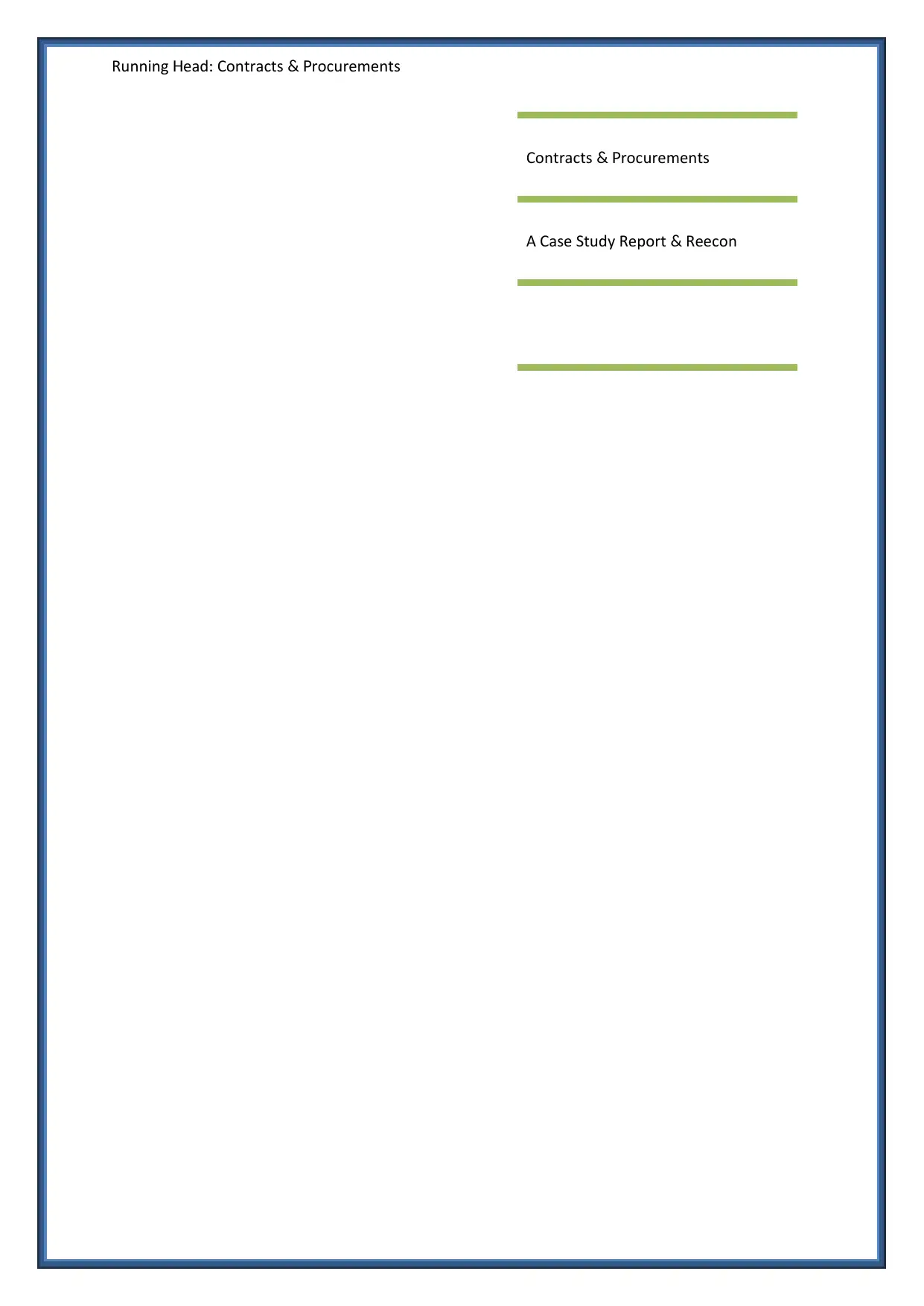
Running ead Contracts rocurementsH : & P
Contracts rocurements& P
A Case Study Report Reflection&
Contracts rocurements& P
A Case Study Report Reflection&
Paraphrase This Document
Need a fresh take? Get an instant paraphrase of this document with our AI Paraphraser

Contracts rocurements& P a g eP | 1
Table of Content
Part A-Introduction......................................................................................................................................... 2
Part B-Key Risks, Mitigation and Possible learning’s........................................................................3
Key Risks......................................................................................................................................................... 3
Risk Mitigation.............................................................................................................................................. 4
Key Learning’s.............................................................................................................................................. 5
Part C-Summary of Key findings and best practices in contract and procurement
managements.................................................................................................................................................... 6
Summary of the Key findings.................................................................................................................. 6
Best Practices in Procurement and Contract Management........................................................6
Part D-Reflection.............................................................................................................................................. 7
References........................................................................................................................................................... 9
Table of Content
Part A-Introduction......................................................................................................................................... 2
Part B-Key Risks, Mitigation and Possible learning’s........................................................................3
Key Risks......................................................................................................................................................... 3
Risk Mitigation.............................................................................................................................................. 4
Key Learning’s.............................................................................................................................................. 5
Part C-Summary of Key findings and best practices in contract and procurement
managements.................................................................................................................................................... 6
Summary of the Key findings.................................................................................................................. 6
Best Practices in Procurement and Contract Management........................................................6
Part D-Reflection.............................................................................................................................................. 7
References........................................................................................................................................................... 9

Contracts rocurements& P a g eP | 2
Part A-Introduction
Procurement and contracts are an integral part of successful project management and it
is one of the most focussed areas for the management of the business organization.
Some of the integral part of the process attached with the project management are
planning for purchase and acquisition, request for proposal, vendor selection, contract
administration and contract closure. The report here will understand the process of
contract and procurement with the help of a case study based on the new Royal
Adelaide Hospital, which is one of the largest social infrastructure project undertaken
by the state. The Public Private Partnership (PPP) agreement is focussed to build,
maintain, finance and facilitate non-medical and equipment services to the hospital. The
hospital is laced with advanced technology and is seen as one of the most celebrated
hospital in South of Australia. An agreement for 35 years has been signed between the
state and the most preferred PPP proponent, SA health partnership Pty ltd. The project
which has an estimated projected cost at US $ 1.85 Billion per year has the following
features in the contract(Grimsey & Lewis, 2017).
Provision for 800 beds which comprise of 700 multi-day beds and 100 same day
beds.
Standardization in the single impatient rooms with individual rooms.
In total 40 Technical suites to be created on the likes of operation rooms,
procedural suites.
Updating the technology to ensure the suppliers in the hospital are transported
safely, effectively and efficiently.
In order to complete the project in the stipulated time, the most important thing here is
establishment of the effective and efficient management oversight process, decision
making system in place and a regularly reviewed and revised throughout the tenure of
the project. The review of the development of the project is an on-going process and the
project has been broken down into several stages and milestones. Some of the
important are of focus include:
Material indent and procurement
Management of risk
Part A-Introduction
Procurement and contracts are an integral part of successful project management and it
is one of the most focussed areas for the management of the business organization.
Some of the integral part of the process attached with the project management are
planning for purchase and acquisition, request for proposal, vendor selection, contract
administration and contract closure. The report here will understand the process of
contract and procurement with the help of a case study based on the new Royal
Adelaide Hospital, which is one of the largest social infrastructure project undertaken
by the state. The Public Private Partnership (PPP) agreement is focussed to build,
maintain, finance and facilitate non-medical and equipment services to the hospital. The
hospital is laced with advanced technology and is seen as one of the most celebrated
hospital in South of Australia. An agreement for 35 years has been signed between the
state and the most preferred PPP proponent, SA health partnership Pty ltd. The project
which has an estimated projected cost at US $ 1.85 Billion per year has the following
features in the contract(Grimsey & Lewis, 2017).
Provision for 800 beds which comprise of 700 multi-day beds and 100 same day
beds.
Standardization in the single impatient rooms with individual rooms.
In total 40 Technical suites to be created on the likes of operation rooms,
procedural suites.
Updating the technology to ensure the suppliers in the hospital are transported
safely, effectively and efficiently.
In order to complete the project in the stipulated time, the most important thing here is
establishment of the effective and efficient management oversight process, decision
making system in place and a regularly reviewed and revised throughout the tenure of
the project. The review of the development of the project is an on-going process and the
project has been broken down into several stages and milestones. Some of the
important are of focus include:
Material indent and procurement
Management of risk
⊘ This is a preview!⊘
Do you want full access?
Subscribe today to unlock all pages.

Trusted by 1+ million students worldwide

Contracts rocurements& P a g eP | 3
Management and administration of contract
Planning of business
Process of assurance
Organizational structure and project governance (Saunders & Carter, 2017).
At the very present, the design and construction work is seen by the subcontracted
builder and maximum of the design work is in the completion stage, on the other hand
the construction work is going in full swing. The work which is funded by the state
department of planning, transport and infrastructure has to go into the progress state.
An internal audit on the completion of project undertaken by the SA health during
2014-15 reflected that the work is running behind the schedule and the earlier
completion date of 2016 has to be extended. The delay in the project has put an
additional expenditure on both the public and private partnership and the stakeholders
of the project are running behind to ensure no further delay in the project completion. It
was identified that plethora of areas such as Program governance, assurance,
management, reporting system and processes require a lot of improvement to expedite
the process(Walker, 2017).
A lot of risk was identified with the project, and in order to tackle the same a team was
created to monitor and have an overview of the project contingency management
framework, revisiting reporting on the status of clinical equipment procurement,
enhanced risk, budgetary and financial management risks. At the same point in time not
all the projections and forecasts linked to the project had a significant variation which
resulted in the increase in the cost of project. The report in the next section will focus on
various key risks associated with the project; risk mitigation and the possible learning’s
one can derive from the grand project. Towards the end, a summary of the key findings
will be presented along with the best possible practices in procurement and contract
management (Redwood et. al., 2017).
Part B-Key Risks, Mitigation and Possible learning’s
Key Risks
The new RAH project is under a lot of risks related to its scale, complexity, cost
and the resources allocated to the project.
Management and administration of contract
Planning of business
Process of assurance
Organizational structure and project governance (Saunders & Carter, 2017).
At the very present, the design and construction work is seen by the subcontracted
builder and maximum of the design work is in the completion stage, on the other hand
the construction work is going in full swing. The work which is funded by the state
department of planning, transport and infrastructure has to go into the progress state.
An internal audit on the completion of project undertaken by the SA health during
2014-15 reflected that the work is running behind the schedule and the earlier
completion date of 2016 has to be extended. The delay in the project has put an
additional expenditure on both the public and private partnership and the stakeholders
of the project are running behind to ensure no further delay in the project completion. It
was identified that plethora of areas such as Program governance, assurance,
management, reporting system and processes require a lot of improvement to expedite
the process(Walker, 2017).
A lot of risk was identified with the project, and in order to tackle the same a team was
created to monitor and have an overview of the project contingency management
framework, revisiting reporting on the status of clinical equipment procurement,
enhanced risk, budgetary and financial management risks. At the same point in time not
all the projections and forecasts linked to the project had a significant variation which
resulted in the increase in the cost of project. The report in the next section will focus on
various key risks associated with the project; risk mitigation and the possible learning’s
one can derive from the grand project. Towards the end, a summary of the key findings
will be presented along with the best possible practices in procurement and contract
management (Redwood et. al., 2017).
Part B-Key Risks, Mitigation and Possible learning’s
Key Risks
The new RAH project is under a lot of risks related to its scale, complexity, cost
and the resources allocated to the project.
Paraphrase This Document
Need a fresh take? Get an instant paraphrase of this document with our AI Paraphraser

Contracts rocurements& P a g eP | 4
The project is also at risk in terms of its capabilities to provide enhanced and
sustainable health care services and outcome to the population of South
Australia (Wales, 2014).
The PPP model has transferred a major proportion of risk onto the Project Co,
which includes the risk in the areas of design and construction.
Plethora of risk was contained by the state in terms of clinical services, clinical
equipment’s, and influence of the ICT and the schedule of construction.
Another major risk associated with the project was the contractual agreement
under which the state was supposed to comply with the specific time frames. A
failure by the state government to coordinate the activities and services it is
required to provide for the operations to the Project Co, have high chances that
the state might not be in a position to realize the intended benefits from the
projects(Regan, Smith & Love, 2015).
One of the major risk was identified as the project risk, which encompassed the
completion time of the project, cost incurred and the ecosystem of the services to
be provided by the state was under a lot of financial constraints.
Financial risk was the most felt in the construction of New RAH project. As the
state was supposed to take all the necessary approvals from the government, the
time incurred in taking the approvals resulted in significant risk at the hospital.
There was an absolute failure to meet the contractual requirement and the
guidelines of the PPP which exposed the project to a lot of financial burden.
A lot of claim made against the statement were under lens which further delayed
the project.
There were a lot of industrial disputes happening at the same time, the disputes
can be referred to as union disputes, clinical disputes and more such disputes
(Rahmani, Maqsood & Khalfan, 2017).
As ICT was one of the most important elements of the project, inadequate
delivery of the health enterprise ICT systems was thus seen as a huge risk.
The staffs were inadequately trained to undergo a transition.
The sustainable model of care, which was one of the identified goal of the new
RAH project was in big jeopardy.
There was a sense of confusion with respect to the change brought into the
health care policy of the state and its strategic directions.
The project is also at risk in terms of its capabilities to provide enhanced and
sustainable health care services and outcome to the population of South
Australia (Wales, 2014).
The PPP model has transferred a major proportion of risk onto the Project Co,
which includes the risk in the areas of design and construction.
Plethora of risk was contained by the state in terms of clinical services, clinical
equipment’s, and influence of the ICT and the schedule of construction.
Another major risk associated with the project was the contractual agreement
under which the state was supposed to comply with the specific time frames. A
failure by the state government to coordinate the activities and services it is
required to provide for the operations to the Project Co, have high chances that
the state might not be in a position to realize the intended benefits from the
projects(Regan, Smith & Love, 2015).
One of the major risk was identified as the project risk, which encompassed the
completion time of the project, cost incurred and the ecosystem of the services to
be provided by the state was under a lot of financial constraints.
Financial risk was the most felt in the construction of New RAH project. As the
state was supposed to take all the necessary approvals from the government, the
time incurred in taking the approvals resulted in significant risk at the hospital.
There was an absolute failure to meet the contractual requirement and the
guidelines of the PPP which exposed the project to a lot of financial burden.
A lot of claim made against the statement were under lens which further delayed
the project.
There were a lot of industrial disputes happening at the same time, the disputes
can be referred to as union disputes, clinical disputes and more such disputes
(Rahmani, Maqsood & Khalfan, 2017).
As ICT was one of the most important elements of the project, inadequate
delivery of the health enterprise ICT systems was thus seen as a huge risk.
The staffs were inadequately trained to undergo a transition.
The sustainable model of care, which was one of the identified goal of the new
RAH project was in big jeopardy.
There was a sense of confusion with respect to the change brought into the
health care policy of the state and its strategic directions.
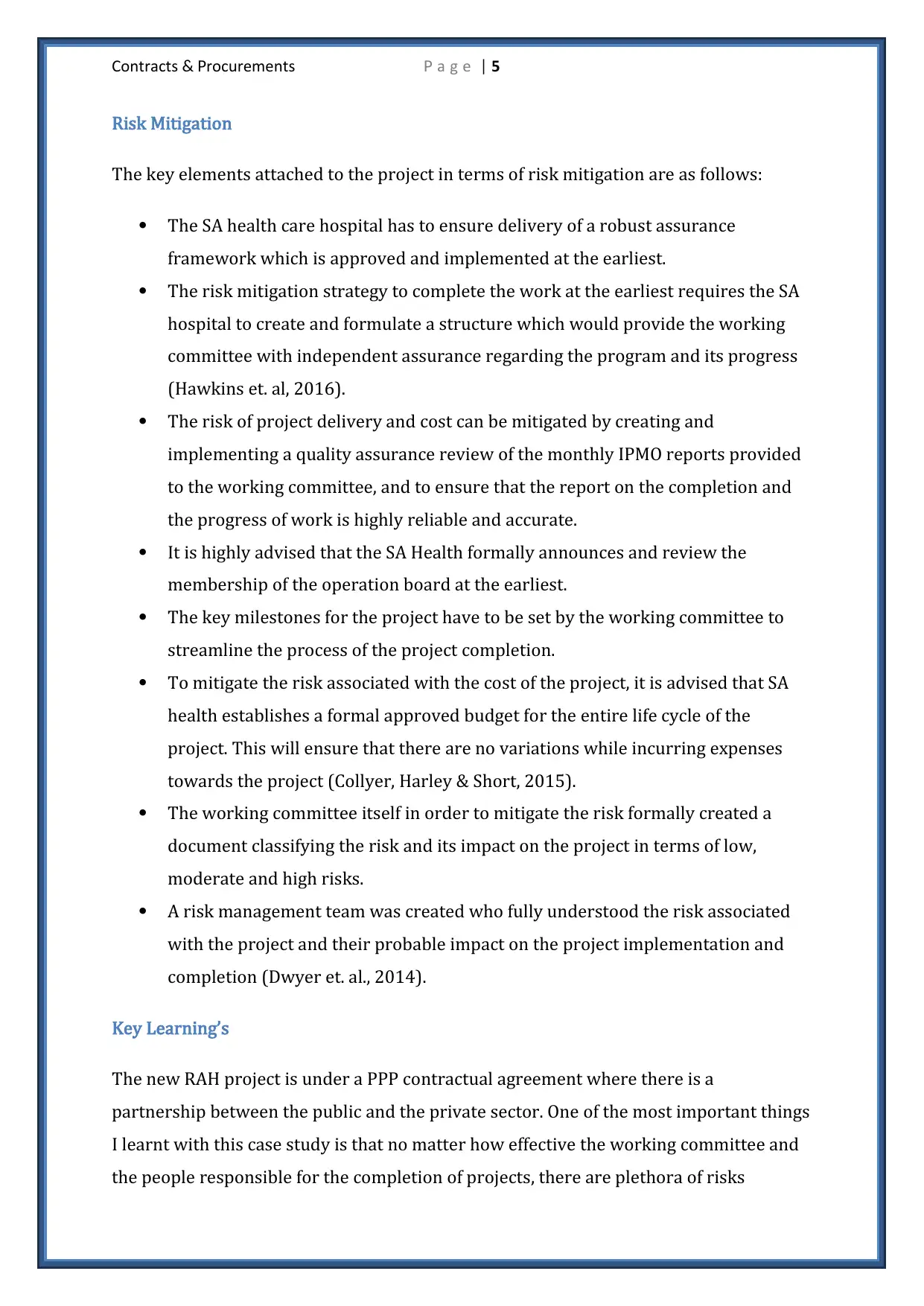
Contracts rocurements& P a g eP | 5
Risk Mitigation
The key elements attached to the project in terms of risk mitigation are as follows:
The SA health care hospital has to ensure delivery of a robust assurance
framework which is approved and implemented at the earliest.
The risk mitigation strategy to complete the work at the earliest requires the SA
hospital to create and formulate a structure which would provide the working
committee with independent assurance regarding the program and its progress
(Hawkins et. al, 2016).
The risk of project delivery and cost can be mitigated by creating and
implementing a quality assurance review of the monthly IPMO reports provided
to the working committee, and to ensure that the report on the completion and
the progress of work is highly reliable and accurate.
It is highly advised that the SA Health formally announces and review the
membership of the operation board at the earliest.
The key milestones for the project have to be set by the working committee to
streamline the process of the project completion.
To mitigate the risk associated with the cost of the project, it is advised that SA
health establishes a formal approved budget for the entire life cycle of the
project. This will ensure that there are no variations while incurring expenses
towards the project (Collyer, Harley & Short, 2015).
The working committee itself in order to mitigate the risk formally created a
document classifying the risk and its impact on the project in terms of low,
moderate and high risks.
A risk management team was created who fully understood the risk associated
with the project and their probable impact on the project implementation and
completion (Dwyer et. al., 2014).
Key Learning’s
The new RAH project is under a PPP contractual agreement where there is a
partnership between the public and the private sector. One of the most important things
I learnt with this case study is that no matter how effective the working committee and
the people responsible for the completion of projects, there are plethora of risks
Risk Mitigation
The key elements attached to the project in terms of risk mitigation are as follows:
The SA health care hospital has to ensure delivery of a robust assurance
framework which is approved and implemented at the earliest.
The risk mitigation strategy to complete the work at the earliest requires the SA
hospital to create and formulate a structure which would provide the working
committee with independent assurance regarding the program and its progress
(Hawkins et. al, 2016).
The risk of project delivery and cost can be mitigated by creating and
implementing a quality assurance review of the monthly IPMO reports provided
to the working committee, and to ensure that the report on the completion and
the progress of work is highly reliable and accurate.
It is highly advised that the SA Health formally announces and review the
membership of the operation board at the earliest.
The key milestones for the project have to be set by the working committee to
streamline the process of the project completion.
To mitigate the risk associated with the cost of the project, it is advised that SA
health establishes a formal approved budget for the entire life cycle of the
project. This will ensure that there are no variations while incurring expenses
towards the project (Collyer, Harley & Short, 2015).
The working committee itself in order to mitigate the risk formally created a
document classifying the risk and its impact on the project in terms of low,
moderate and high risks.
A risk management team was created who fully understood the risk associated
with the project and their probable impact on the project implementation and
completion (Dwyer et. al., 2014).
Key Learning’s
The new RAH project is under a PPP contractual agreement where there is a
partnership between the public and the private sector. One of the most important things
I learnt with this case study is that no matter how effective the working committee and
the people responsible for the completion of projects, there are plethora of risks
⊘ This is a preview!⊘
Do you want full access?
Subscribe today to unlock all pages.

Trusted by 1+ million students worldwide
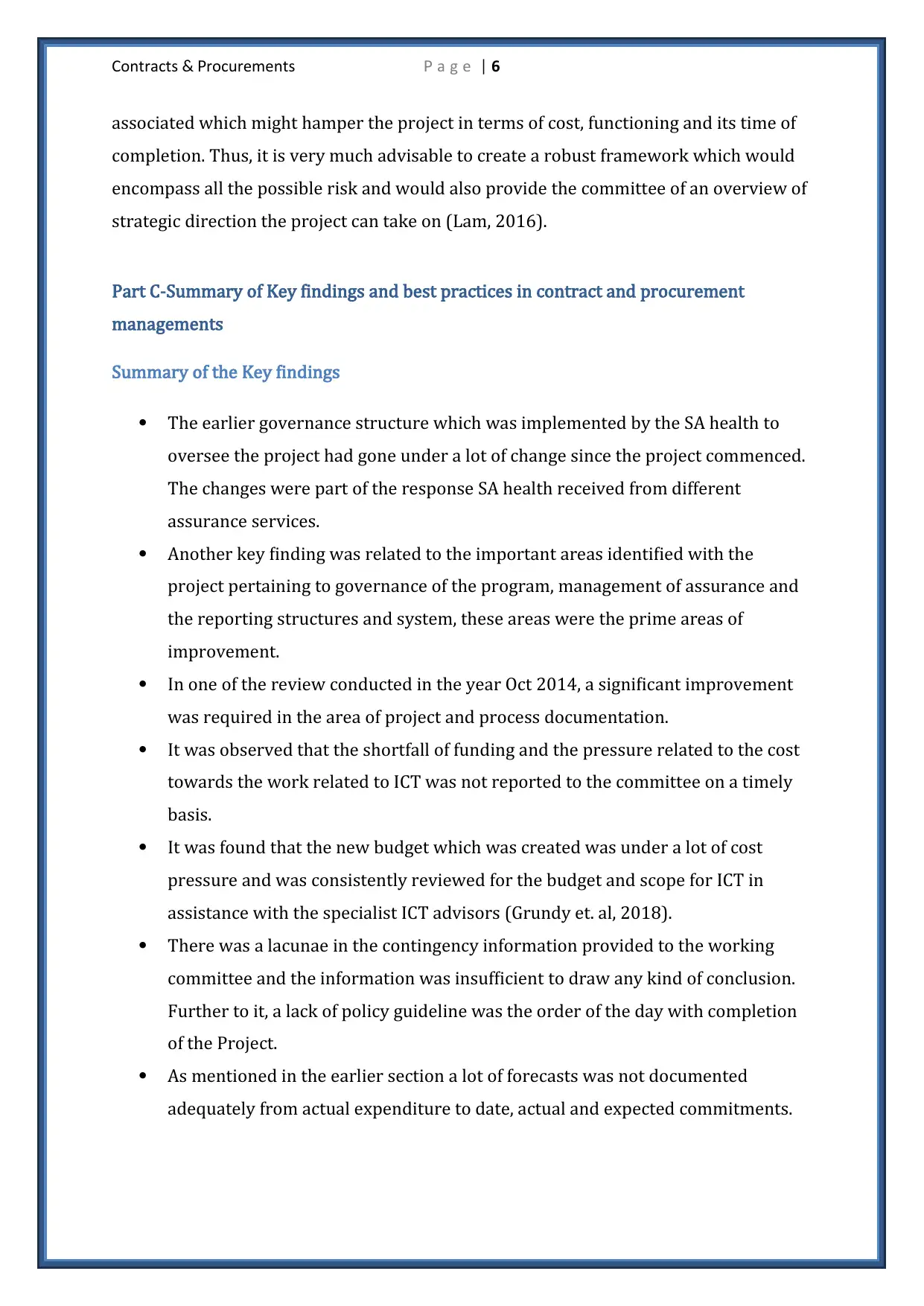
Contracts rocurements& P a g eP | 6
associated which might hamper the project in terms of cost, functioning and its time of
completion. Thus, it is very much advisable to create a robust framework which would
encompass all the possible risk and would also provide the committee of an overview of
strategic direction the project can take on (Lam, 2016).
Part C-Summary of Key findings and best practices in contract and procurement
managements
Summary of the Key findings
The earlier governance structure which was implemented by the SA health to
oversee the project had gone under a lot of change since the project commenced.
The changes were part of the response SA health received from different
assurance services.
Another key finding was related to the important areas identified with the
project pertaining to governance of the program, management of assurance and
the reporting structures and system, these areas were the prime areas of
improvement.
In one of the review conducted in the year Oct 2014, a significant improvement
was required in the area of project and process documentation.
It was observed that the shortfall of funding and the pressure related to the cost
towards the work related to ICT was not reported to the committee on a timely
basis.
It was found that the new budget which was created was under a lot of cost
pressure and was consistently reviewed for the budget and scope for ICT in
assistance with the specialist ICT advisors (Grundy et. al, 2018).
There was a lacunae in the contingency information provided to the working
committee and the information was insufficient to draw any kind of conclusion.
Further to it, a lack of policy guideline was the order of the day with completion
of the Project.
As mentioned in the earlier section a lot of forecasts was not documented
adequately from actual expenditure to date, actual and expected commitments.
associated which might hamper the project in terms of cost, functioning and its time of
completion. Thus, it is very much advisable to create a robust framework which would
encompass all the possible risk and would also provide the committee of an overview of
strategic direction the project can take on (Lam, 2016).
Part C-Summary of Key findings and best practices in contract and procurement
managements
Summary of the Key findings
The earlier governance structure which was implemented by the SA health to
oversee the project had gone under a lot of change since the project commenced.
The changes were part of the response SA health received from different
assurance services.
Another key finding was related to the important areas identified with the
project pertaining to governance of the program, management of assurance and
the reporting structures and system, these areas were the prime areas of
improvement.
In one of the review conducted in the year Oct 2014, a significant improvement
was required in the area of project and process documentation.
It was observed that the shortfall of funding and the pressure related to the cost
towards the work related to ICT was not reported to the committee on a timely
basis.
It was found that the new budget which was created was under a lot of cost
pressure and was consistently reviewed for the budget and scope for ICT in
assistance with the specialist ICT advisors (Grundy et. al, 2018).
There was a lacunae in the contingency information provided to the working
committee and the information was insufficient to draw any kind of conclusion.
Further to it, a lack of policy guideline was the order of the day with completion
of the Project.
As mentioned in the earlier section a lot of forecasts was not documented
adequately from actual expenditure to date, actual and expected commitments.
Paraphrase This Document
Need a fresh take? Get an instant paraphrase of this document with our AI Paraphraser
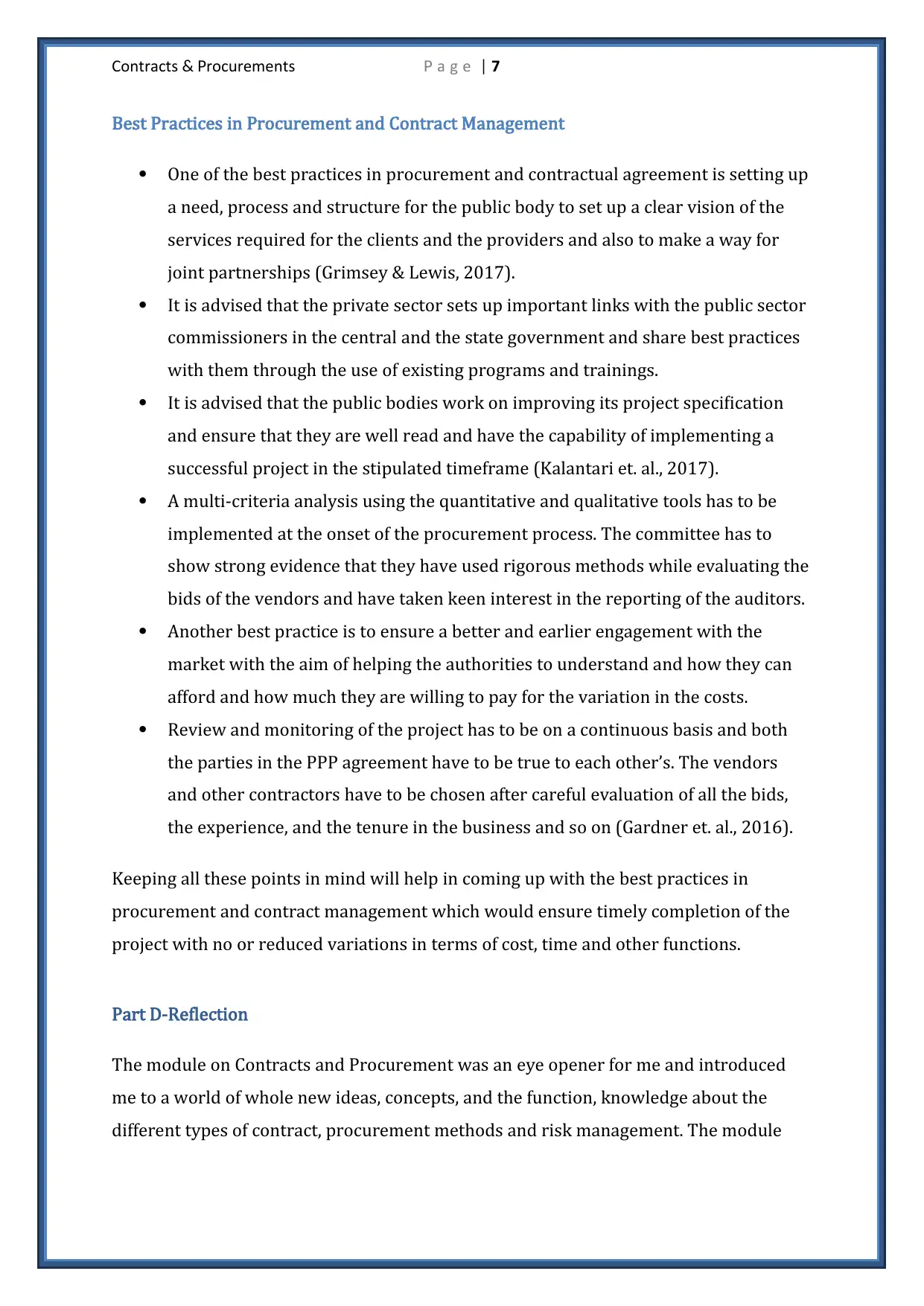
Contracts rocurements& P a g eP | 7
Best Practices in Procurement and Contract Management
One of the best practices in procurement and contractual agreement is setting up
a need, process and structure for the public body to set up a clear vision of the
services required for the clients and the providers and also to make a way for
joint partnerships (Grimsey & Lewis, 2017).
It is advised that the private sector sets up important links with the public sector
commissioners in the central and the state government and share best practices
with them through the use of existing programs and trainings.
It is advised that the public bodies work on improving its project specification
and ensure that they are well read and have the capability of implementing a
successful project in the stipulated timeframe (Kalantari et. al., 2017).
A multi-criteria analysis using the quantitative and qualitative tools has to be
implemented at the onset of the procurement process. The committee has to
show strong evidence that they have used rigorous methods while evaluating the
bids of the vendors and have taken keen interest in the reporting of the auditors.
Another best practice is to ensure a better and earlier engagement with the
market with the aim of helping the authorities to understand and how they can
afford and how much they are willing to pay for the variation in the costs.
Review and monitoring of the project has to be on a continuous basis and both
the parties in the PPP agreement have to be true to each other’s. The vendors
and other contractors have to be chosen after careful evaluation of all the bids,
the experience, and the tenure in the business and so on (Gardner et. al., 2016).
Keeping all these points in mind will help in coming up with the best practices in
procurement and contract management which would ensure timely completion of the
project with no or reduced variations in terms of cost, time and other functions.
Part D-Reflection
The module on Contracts and Procurement was an eye opener for me and introduced
me to a world of whole new ideas, concepts, and the function, knowledge about the
different types of contract, procurement methods and risk management. The module
Best Practices in Procurement and Contract Management
One of the best practices in procurement and contractual agreement is setting up
a need, process and structure for the public body to set up a clear vision of the
services required for the clients and the providers and also to make a way for
joint partnerships (Grimsey & Lewis, 2017).
It is advised that the private sector sets up important links with the public sector
commissioners in the central and the state government and share best practices
with them through the use of existing programs and trainings.
It is advised that the public bodies work on improving its project specification
and ensure that they are well read and have the capability of implementing a
successful project in the stipulated timeframe (Kalantari et. al., 2017).
A multi-criteria analysis using the quantitative and qualitative tools has to be
implemented at the onset of the procurement process. The committee has to
show strong evidence that they have used rigorous methods while evaluating the
bids of the vendors and have taken keen interest in the reporting of the auditors.
Another best practice is to ensure a better and earlier engagement with the
market with the aim of helping the authorities to understand and how they can
afford and how much they are willing to pay for the variation in the costs.
Review and monitoring of the project has to be on a continuous basis and both
the parties in the PPP agreement have to be true to each other’s. The vendors
and other contractors have to be chosen after careful evaluation of all the bids,
the experience, and the tenure in the business and so on (Gardner et. al., 2016).
Keeping all these points in mind will help in coming up with the best practices in
procurement and contract management which would ensure timely completion of the
project with no or reduced variations in terms of cost, time and other functions.
Part D-Reflection
The module on Contracts and Procurement was an eye opener for me and introduced
me to a world of whole new ideas, concepts, and the function, knowledge about the
different types of contract, procurement methods and risk management. The module
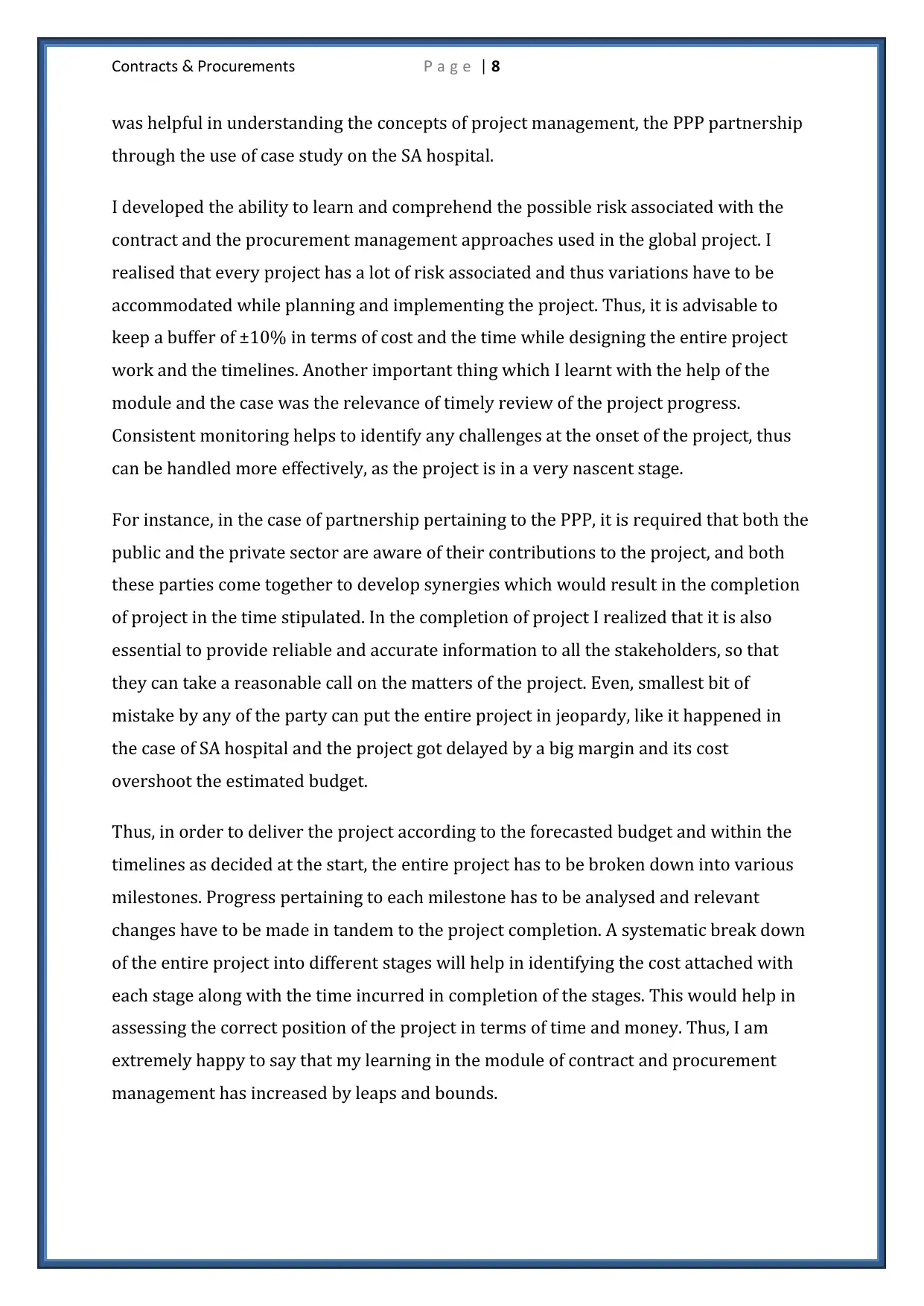
Contracts rocurements& P a g eP | 8
was helpful in understanding the concepts of project management, the PPP partnership
through the use of case study on the SA hospital.
I developed the ability to learn and comprehend the possible risk associated with the
contract and the procurement management approaches used in the global project. I
realised that every project has a lot of risk associated and thus variations have to be
accommodated while planning and implementing the project. Thus, it is advisable to
keep a buffer of ±10% in terms of cost and the time while designing the entire project
work and the timelines. Another important thing which I learnt with the help of the
module and the case was the relevance of timely review of the project progress.
Consistent monitoring helps to identify any challenges at the onset of the project, thus
can be handled more effectively, as the project is in a very nascent stage.
For instance, in the case of partnership pertaining to the PPP, it is required that both the
public and the private sector are aware of their contributions to the project, and both
these parties come together to develop synergies which would result in the completion
of project in the time stipulated. In the completion of project I realized that it is also
essential to provide reliable and accurate information to all the stakeholders, so that
they can take a reasonable call on the matters of the project. Even, smallest bit of
mistake by any of the party can put the entire project in jeopardy, like it happened in
the case of SA hospital and the project got delayed by a big margin and its cost
overshoot the estimated budget.
Thus, in order to deliver the project according to the forecasted budget and within the
timelines as decided at the start, the entire project has to be broken down into various
milestones. Progress pertaining to each milestone has to be analysed and relevant
changes have to be made in tandem to the project completion. A systematic break down
of the entire project into different stages will help in identifying the cost attached with
each stage along with the time incurred in completion of the stages. This would help in
assessing the correct position of the project in terms of time and money. Thus, I am
extremely happy to say that my learning in the module of contract and procurement
management has increased by leaps and bounds.
was helpful in understanding the concepts of project management, the PPP partnership
through the use of case study on the SA hospital.
I developed the ability to learn and comprehend the possible risk associated with the
contract and the procurement management approaches used in the global project. I
realised that every project has a lot of risk associated and thus variations have to be
accommodated while planning and implementing the project. Thus, it is advisable to
keep a buffer of ±10% in terms of cost and the time while designing the entire project
work and the timelines. Another important thing which I learnt with the help of the
module and the case was the relevance of timely review of the project progress.
Consistent monitoring helps to identify any challenges at the onset of the project, thus
can be handled more effectively, as the project is in a very nascent stage.
For instance, in the case of partnership pertaining to the PPP, it is required that both the
public and the private sector are aware of their contributions to the project, and both
these parties come together to develop synergies which would result in the completion
of project in the time stipulated. In the completion of project I realized that it is also
essential to provide reliable and accurate information to all the stakeholders, so that
they can take a reasonable call on the matters of the project. Even, smallest bit of
mistake by any of the party can put the entire project in jeopardy, like it happened in
the case of SA hospital and the project got delayed by a big margin and its cost
overshoot the estimated budget.
Thus, in order to deliver the project according to the forecasted budget and within the
timelines as decided at the start, the entire project has to be broken down into various
milestones. Progress pertaining to each milestone has to be analysed and relevant
changes have to be made in tandem to the project completion. A systematic break down
of the entire project into different stages will help in identifying the cost attached with
each stage along with the time incurred in completion of the stages. This would help in
assessing the correct position of the project in terms of time and money. Thus, I am
extremely happy to say that my learning in the module of contract and procurement
management has increased by leaps and bounds.
⊘ This is a preview!⊘
Do you want full access?
Subscribe today to unlock all pages.

Trusted by 1+ million students worldwide
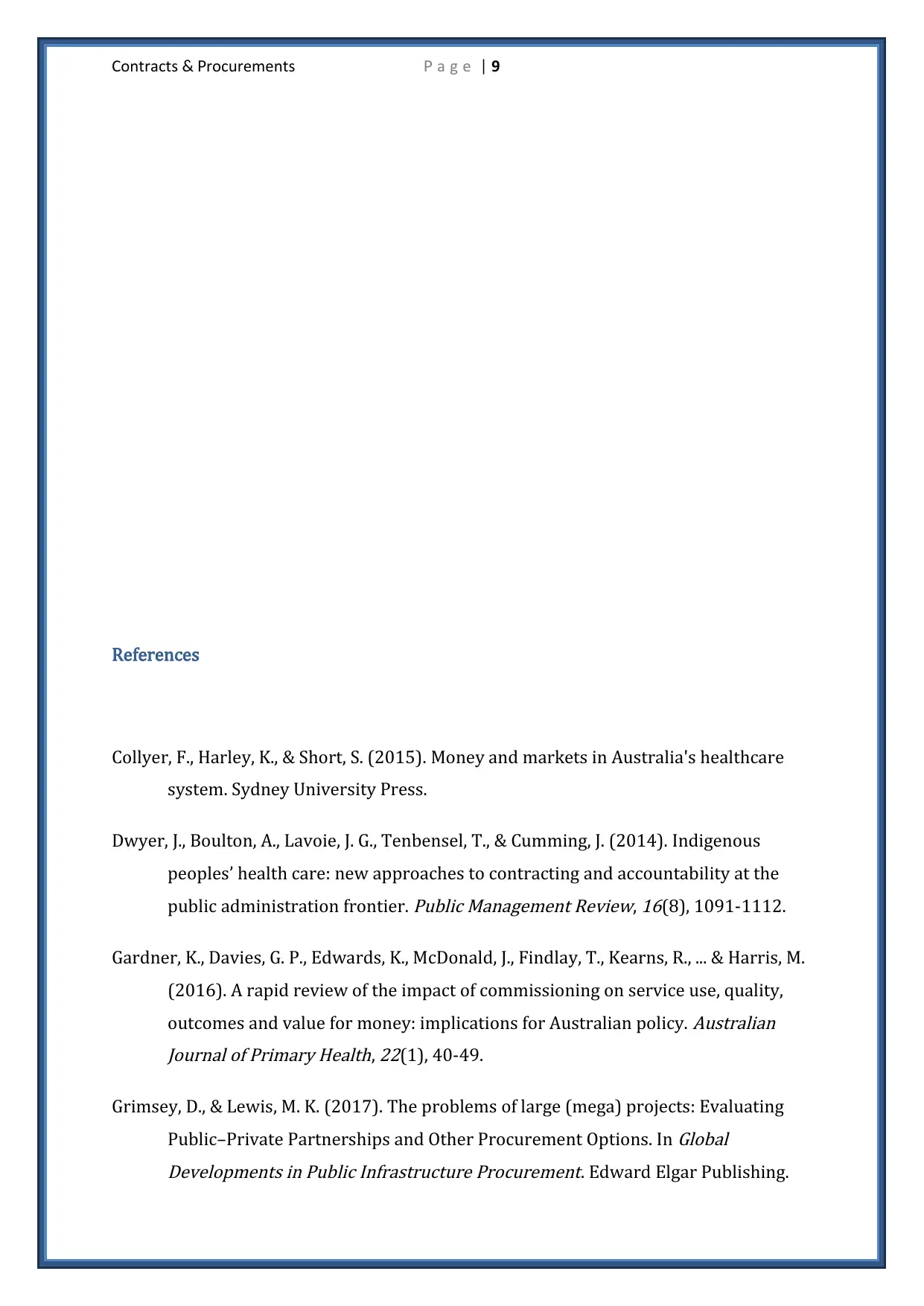
Contracts rocurements& P a g eP | 9
References
Collyer, F., Harley, K., & Short, S. (2015). Money and markets in Australia's healthcare
system. Sydney University Press.
Dwyer, J., Boulton, A., Lavoie, J. G., Tenbensel, T., & Cumming, J. (2014). Indigenous
peoples’ health care: new approaches to contracting and accountability at the
public administration frontier.
Public Management Review,
16(8), 1091-1112.
Gardner, K., Davies, G. P., Edwards, K., McDonald, J., Findlay, T., Kearns, R., ... & Harris, M.
(2016). A rapid review of the impact of commissioning on service use, quality,
outcomes and value for money: implications for Australian policy.
Australian
Journal of Primary Health,
22(1), 40-49.
Grimsey, D., & Lewis, M. K. (2017). The problems of large (mega) projects: Evaluating
Public–Private Partnerships and Other Procurement Options. In
Global
Developments in Public Infrastructure Procurement. Edward Elgar Publishing.
References
Collyer, F., Harley, K., & Short, S. (2015). Money and markets in Australia's healthcare
system. Sydney University Press.
Dwyer, J., Boulton, A., Lavoie, J. G., Tenbensel, T., & Cumming, J. (2014). Indigenous
peoples’ health care: new approaches to contracting and accountability at the
public administration frontier.
Public Management Review,
16(8), 1091-1112.
Gardner, K., Davies, G. P., Edwards, K., McDonald, J., Findlay, T., Kearns, R., ... & Harris, M.
(2016). A rapid review of the impact of commissioning on service use, quality,
outcomes and value for money: implications for Australian policy.
Australian
Journal of Primary Health,
22(1), 40-49.
Grimsey, D., & Lewis, M. K. (2017). The problems of large (mega) projects: Evaluating
Public–Private Partnerships and Other Procurement Options. In
Global
Developments in Public Infrastructure Procurement. Edward Elgar Publishing.
Paraphrase This Document
Need a fresh take? Get an instant paraphrase of this document with our AI Paraphraser
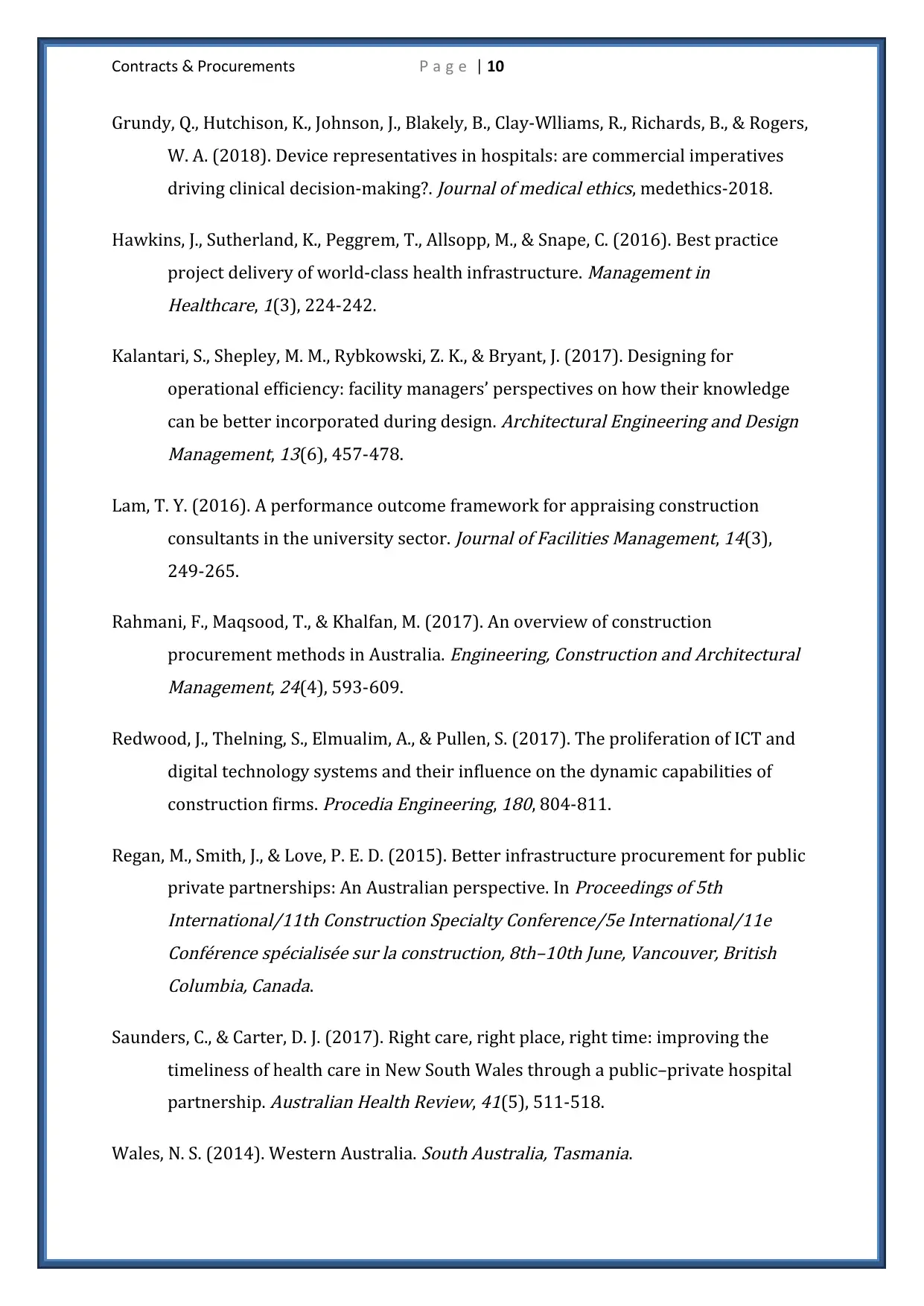
Contracts rocurements& P a g eP | 10
Grundy, Q., Hutchison, K., Johnson, J., Blakely, B., Clay-Wlliams, R., Richards, B., & Rogers,
W. A. (2018). Device representatives in hospitals: are commercial imperatives
driving clinical decision-making?.
Journal of medical ethics, medethics-2018.
Hawkins, J., Sutherland, K., Peggrem, T., Allsopp, M., & Snape, C. (2016). Best practice
project delivery of world-class health infrastructure.
Management in
Healthcare,
1(3), 224-242.
Kalantari, S., Shepley, M. M., Rybkowski, Z. K., & Bryant, J. (2017). Designing for
operational efficiency: facility managers’ perspectives on how their knowledge
can be better incorporated during design.
Architectural Engineering and Design
Management,
13(6), 457-478.
Lam, T. Y. (2016). A performance outcome framework for appraising construction
consultants in the university sector.
Journal of Facilities Management,
14(3),
249-265.
Rahmani, F., Maqsood, T., & Khalfan, M. (2017). An overview of construction
procurement methods in Australia.
Engineering, Construction and Architectural
Management,
24(4), 593-609.
Redwood, J., Thelning, S., Elmualim, A., & Pullen, S. (2017). The proliferation of ICT and
digital technology systems and their influence on the dynamic capabilities of
construction firms.
Procedia Engineering,
180, 804-811.
Regan, M., Smith, J., & Love, P. E. D. (2015). Better infrastructure procurement for public
private partnerships: An Australian perspective. In
Proceedings of 5th
International/11th Construction Specialty Conference/5e International/11e
ConfeOrence speOcialiseOe sur la construction, 8th–10th June, Vancouver, British
Columbia, Canada.
Saunders, C., & Carter, D. J. (2017). Right care, right place, right time: improving the
timeliness of health care in New South Wales through a public–private hospital
partnership.
Australian Health Review,
41(5), 511-518.
Wales, N. S. (2014). Western Australia.
South Australia, Tasmania.
Grundy, Q., Hutchison, K., Johnson, J., Blakely, B., Clay-Wlliams, R., Richards, B., & Rogers,
W. A. (2018). Device representatives in hospitals: are commercial imperatives
driving clinical decision-making?.
Journal of medical ethics, medethics-2018.
Hawkins, J., Sutherland, K., Peggrem, T., Allsopp, M., & Snape, C. (2016). Best practice
project delivery of world-class health infrastructure.
Management in
Healthcare,
1(3), 224-242.
Kalantari, S., Shepley, M. M., Rybkowski, Z. K., & Bryant, J. (2017). Designing for
operational efficiency: facility managers’ perspectives on how their knowledge
can be better incorporated during design.
Architectural Engineering and Design
Management,
13(6), 457-478.
Lam, T. Y. (2016). A performance outcome framework for appraising construction
consultants in the university sector.
Journal of Facilities Management,
14(3),
249-265.
Rahmani, F., Maqsood, T., & Khalfan, M. (2017). An overview of construction
procurement methods in Australia.
Engineering, Construction and Architectural
Management,
24(4), 593-609.
Redwood, J., Thelning, S., Elmualim, A., & Pullen, S. (2017). The proliferation of ICT and
digital technology systems and their influence on the dynamic capabilities of
construction firms.
Procedia Engineering,
180, 804-811.
Regan, M., Smith, J., & Love, P. E. D. (2015). Better infrastructure procurement for public
private partnerships: An Australian perspective. In
Proceedings of 5th
International/11th Construction Specialty Conference/5e International/11e
ConfeOrence speOcialiseOe sur la construction, 8th–10th June, Vancouver, British
Columbia, Canada.
Saunders, C., & Carter, D. J. (2017). Right care, right place, right time: improving the
timeliness of health care in New South Wales through a public–private hospital
partnership.
Australian Health Review,
41(5), 511-518.
Wales, N. S. (2014). Western Australia.
South Australia, Tasmania.

Contracts rocurements& P a g eP | 11
Walker, J. (2017). Optimism bias of governance groups: A defence against lack of
presumed knowledge.
Socio-analysis,
19, 51.
Walker, J. (2017). Optimism bias of governance groups: A defence against lack of
presumed knowledge.
Socio-analysis,
19, 51.
⊘ This is a preview!⊘
Do you want full access?
Subscribe today to unlock all pages.

Trusted by 1+ million students worldwide
1 out of 12
Related Documents
Your All-in-One AI-Powered Toolkit for Academic Success.
+13062052269
info@desklib.com
Available 24*7 on WhatsApp / Email
![[object Object]](/_next/static/media/star-bottom.7253800d.svg)
Unlock your academic potential
Copyright © 2020–2025 A2Z Services. All Rights Reserved. Developed and managed by ZUCOL.





